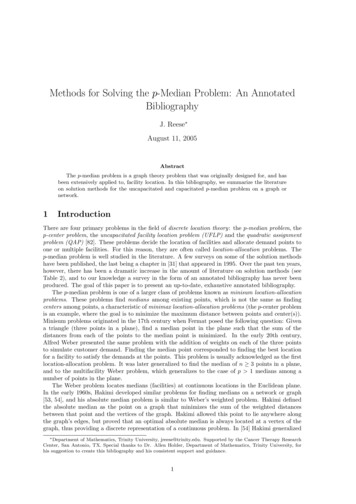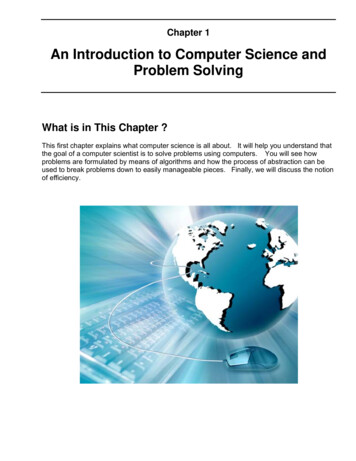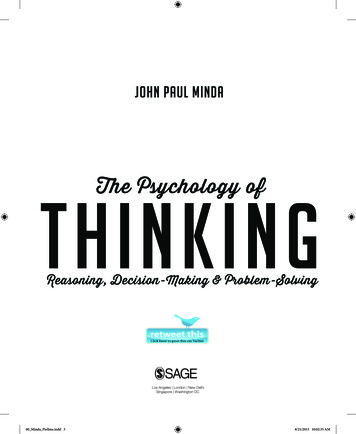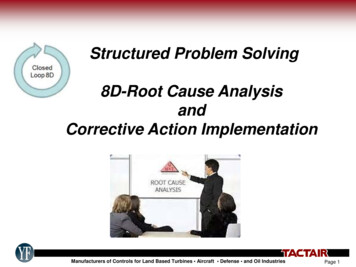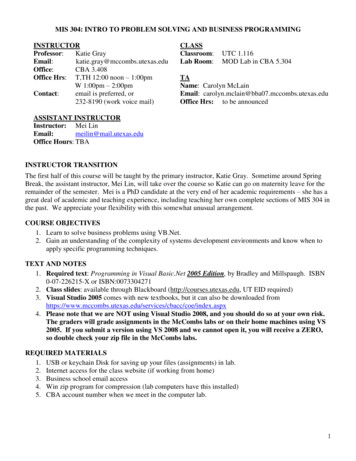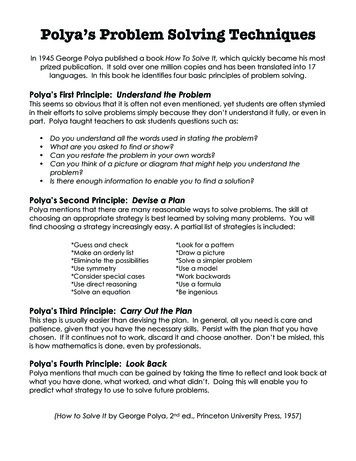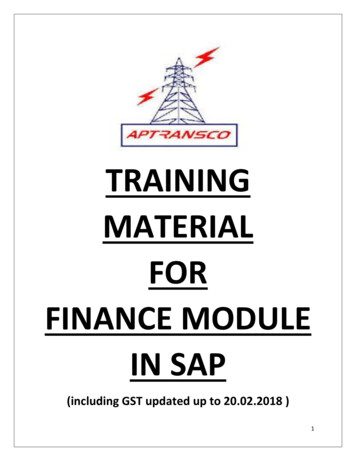
Transcription
Training ModuleonProblem SolvingPopularizing sustainable policies that impactschool to work transition of the youthPage 1 of 11N Y S C
ForewordUNESCAP provides technical and financial aid to facilitate the recognition and enforcement ofpolicies that affect the student and youth population who undergo 'school to work transition'. Thefocal points of this can be categorised as follows, Empowering the youth on policies that benefit all stakeholders Empowerment of policy makers Effective distribution of the positive effects of successful policies among all parties Enhancing the interrelationship among different stakeholders Enhancing the working capacity through trainingDrawing on the advantages of Information and Communication Technology, the Ministry ofNational Policies and Economic Affairs, national and private institutions which enforce policies thataffect the population which undergo school to work transition, and other institutions whichimplement motivational programs for the targeted group, expects to formulate innovative policies.NYSC, as the leading national youth development organization in Sri Lanka, implements pragmaticapproaches in enforcing policies that affect school to work transition, utilizing the support of thirdparties, technical assistance and strategic methods. By effectively employing human resources withnational and international exposure, it is expected to introduce novel tools and training modules toincrease working capacity.Thus, the aforementioned tools and resources will be utilized for a wider institutional involvementand better exchange of knowledge and experience among countries. The youth in the field ofvocational and professional training in Sri Lanka and other regional countries can make use of thetraining modules produced to meet the demands of their working environments.N Y S CPage 2 of 11
Editorial:This training module provides technical guidance on the skills that should be achieved by studentsand the youth community in their transition from school to the corporate world. The trainingmodule is prepared to help youth policy makers, teachers, professional trainers, other trainingfacilitators and the youth community to enhance service capacities through self-exploration.In executing this training module, the training time period shall be decided by the chief serviceprovider. The subject area has been scheduled to enable training time periods to be either one dayor two and a half day training programmes based on the needs of the target group. The subjectmatter should be utilized in a manner which would enable a one day refresher discussionconsequent to the training.Studying the training module before the commencement of the training programme is thedisposition of a skilled and experienced trainer. Therefore, we expect that you will study andexamine both the training module and the training programme. This would in turn instill selfconfidence within you. Hence we assert that it is your duty as a trainer to study in depth and gatherinformation on the subject area beyond what is included in the training module. This module willprovide you with the necessary guidance. The module will furnish the required technical directionand subject matter needed for a skilled trainer to confidently conduct a sustainable and effectivetraining session.Accordingly, steps should be taken to execute a high level training programme making use of thewell formulated session plan and supporting material. Apart from that, we recommend that you useservices of an assistant trainer which would aid you direct your attention to areas that you mightpossibly overlook.N Y S CPage 3 of 11
Module Handbook for Problem SolvingContentsPart 1 – Introduction about the Soft skills Handbook, Daily and Important Objectives, Advice forYouthPart 2 – Objective of the Soft skills ModuleContentsPage NoObjective of the Training Module05Nature of the Soft skills Training (Training Time Period)05Description of the Training Field: (Training Content)06-Definition of a Problem06-Main causes for a Problem06-Brainstorming ideas for Problematic Situations07-Problem Solving and Decision Making Process08-Use of skills for Problem Solving09-Session plan on Skill Development10Page 4 of 11
Part 1IntroductionAims and Objectives:The youth in transition from school to work must develop skills within themselves to independentlyresolve problems they will encounter regularly. It is the policy makers’ responsibility to providenecessary facilities to support them in this regard. Hence, we aim to train the student and youthpopulation in problem-solving skills, which will assist them in adapting to situations and therebyensure a successful entrance into their working environments.Guidelines for Trainers:Identify your target group. Prepare the training programme and its session plan. Use youth-centeredtraining methods which enables you to make a more qualitative change. The Training is expected tobe interactive and to achieve the aims outlined for the youth skills’ development.Part 2Objectives of the Training Module:At the end of this training session, participants will be able to,1. Understand “What is a Problem?”2. Identify causes of a problem3. Analyze problematic situations to discern their nature and manage them.4. Utilize effective problem-solving strategies5. Solve problems in their daily lives.Training Framework (Training Duration):Training WorkshopMotivational TrainingWorkshopCapacity BuildingWorkshopFollow-up WorkshopPage 5 of 11DurationOne DayNotesNon-residential2 ½ DaysResidentialOne DayNon-residential
Details of the training field: (Training content)Subject/FieldWhat is a problem?What are the reasons that contribute to theproblem? Difference between hopes andexpected result Mismatched and contradictoryperception by others on your views To establish self defenseAnalysing problem situations Identifying the nature of the problem Constructing alternatives Choosing the best alternative uponassessing all alternative Utilizing the selected alternativeStrategies in solving problems – Assessingthe resultAdvantages and positive impact in solving aproblemFuture measuresObjectives and MechanismsIdentifying multiple problem situations andstepsPresenting information via a role play ofgroup members – The reasons for theoccurrence of problems will be analysedIdentifying parties related to the problem andanalysing the problem through the problemtree.Sharing case studies and exchangingsuccessful experiences.Exchanging problem resolution experiencesand understanding its advantages.Affirmation of strategy utilization. What is a problem?Give all participants a Zoop card each. Firstly, advise them to individually write their opinionon what is a problem. Along with it instruct them to note down the instances of any problem.Afterwards allow them to compare their opinions and ideas with their neighbor and take downon a separate sheet of paper the content that is mutually agreed by both. If both seem to havesimilar opinions it should be written down as one fact. Next, make groups of four and eliminateopinions that are only agreed to by two and list down what is commonly agreed by all four. Upon listing down the commonly agreed facts, find the answer to the question what is aProblem. Consequently, share with the participants the opinion and definitions of the trainer. What are the reasons for the occurrence of a problem?Page 6 of 11
Advice participants to create a role play with members of their respective groups to provideanswers to the above question and its sub titles. Appoint a panel of judges for the role play andfurnish them with marking criteria. The panel of judges should provide feedback reflective ofthe above topic and its sub titles. Final recommendations should be displayed in the form of flipcharts for the benefit of all participants.Directions for the role play:1) All members of the group should be part of either the role play or the panel of judges.2) Trainer should provide assistance in the creation of the role play.3) At the end of the role play, advise to first commend the positive aspects and then discussareas to be improved.4) Advise to create the role play with emphasis on the sub titles. Creating alternatives to solve problematic situations:Use the activity “Traffic Jam Exercise” as it is appropriate to achieve the purpose ofdeveloping the ability to build alternatives to solve problematic situations. Select twoparticipants from each team (with both male and female participation). Place 11 A4 sheets witha gap of 1 ft among each on the floor in a selected area of the room. The 10 participants mustproceed to stand on the sheets in two groups of five facing the other team, with one empty sheetin between the two groups. Instruct the two teams to cross onto the other side.Activity Instructions:1. No group member can move past two others at once.2. A foot placed forward cannot be drawn back.3. No two group members of the same group can proceed in the same direction in any instance.4. There must always be a spot for one to move forward when the two teams are crossing.5. Rule breakers must be warned or taken appropriate measures against.6. Players must refrain from moving or swinging their arms and legs out of their lane. If theydo, they may get injured from vehicles on either side of their lane.7. Limit the activity to a maximum of 20 minutes.Page 7 of 11
The two groups must proceed to move until their initial direction changes entirely. Buildalternatives step by step. Provide room to identify the next alternative if a decision in one instancegoes wrong. Also train the participants to assess every step taken by them to solve the problem.Teams should be exposed assessing the potential consequences of at least two steps forward andtwo steps back following their decision.Problem Analyzing:Choose a problem of significant consequences, thereafter brainstorm and establish the factorsaffecting this problem. Assess the differences between these consequences and their overall societalimpact before attempting to solve this problem and discuss a suitable action plan. For this purpose,draw up the action points on a Problem Tree and by understanding the activity below, attempt toprovide a series of solutions to this problem.Instant EffectStage 1What is theeffect?Core problemStage 2CoreIssueWhat is theeffect?Immediate CouseStage 3What is theeffect?Stage 4Page 8 of 11Effect of theIssueSecondary CouseReason forIssue
Problem solving steps and decision making:1) Clearly identify the problem2) Generate alternative solutions3) Analyse and choose the best possible solution4) Choose the most ideal solution5) Implement the most ideal solution6) Evaluate the resultsImplementation – Team decision making to be presented using Visual Aid.Example: At the end of this course, the teams will join in on a Trip; to this effect the expenses to beborne per person will be decided by the organisation committee. Any participant unable to attend theTrip will be presumed to forego this opportunity for financial reasons.How to get him to participate in the organized trip?STEP1Identify the issue clearlyDirect the group to assess the situation and to identify the realissue faced.Encourage the group to present ideas along differentviewpoints.2Identify the suitable optionsto address the issueMake the group realize the importance of this step in solvingthe problem.Two participants should get together to build suitablealternatives by making use of the knowledge acquired from theabove exercise.3Analyze the suitablesolutionsIt is necessary to think over your ideas thoroughly in order toselect the most suitable solution. To better understand theseconcepts, direct the group to study the following situations.What are the best subjects to be selected for the next studysession? What are the criteria that you considered whenarriving at this selection?Page 9 of 11
4Select the most suitablesolutionIt is important to understand the reason/s behind the strategiesemployed in solving the problem.Advise the group to clearly note down such criteria in a pieceof paper The time invested to solve the problem should be timeefficient,cost efficient and feasible The ideas must be reasons to solve the problem The ideas should not offend or oppose any otherperson.List out the ideas as “our suggestions” and use forconsideration5Execute the selected solution Make the participants realize that the solution arrived at, is theresult of the input of all participants.6Assess the selected solutionSuccessfully solving a problem or the failure to do so dependson the above factors .If the problem is not solved by thesolution arrived at, restart the process all over again.Following these steps may also help you to successfully solve the problems faced in the day to daylife as well.Utilizing skills in solving problems:Use the knowledge acquired here to solve the problems that you face in your household orworkplace.You shall be able to use this knowledge in the issues faced in your personal life.Utilizing this knowledge in the next study sessionProblem solving is a complex skill that is difficult to grasp. But in order to successfully solve aproblem that arises in the workplace or day to day life, it is a necessary skill. You must practice thetechniques given in this module to improve the skill of problem solving. Constant training andinforming oneself of other techniques is also important.Page 10 of 11
Session PlanSubject AreaTime/NoTime30 minsProblem Solving1 Day – 8 HoursLocationTeam Number and TotalPresentationIndividual activitiesGroup activitiesAssistancePictures ,Video clipsMultimedia ComputersZoop card .Zoop card boardFlip chart paper.Marker penPins.Multimedia .ComputersPresentationsGroup activitiesRole playsFlip chart paperFlip chart boardMultimedia .ComputersBuilding alternatives for problematic situationsIdentifying the nature of the problem and create alternatives.Assess all alternatives and use the best selected alternative.PresentationsGroup activities120 minsAnalysing the problemIdentifying the nature of the problemListing the solutions to the problemExecuting the solutions.0630 minsImportance of using strategies in solving problems0730 mins0815 minsPositive impact in solving problems (Advantages & Disadvantages)Importance of using problem solving techniquesSummarizingPresentationsCase studyBrain stormingActing outGroup activitiesAssessing ideas andgroup suggestionsPresenting discussionsA4 PapersGlue/ SellotapeFlip chart paper. boardMultimediaComputersFlip chart paper.flip chart boardMultimedia .ComputersMarker pen010260 mins03120 mins0490 mins05Sub Subject FieldIntroductionDefining the problem/Creating awareness on the nature of the problemWhat is a problem?Give instructions for the activity.Listing problems, discussing about problems and arriving atconclusions.What are the causes of problems?Provide instructions on conducting activities to explain problematicsituations, discussion and arriving at conclusions.MethdologyPresentationFacilitator: Page 11 of 11PresentationsFlip chart paper, Flip chartboard.Marker penFlip chart paper.flip chart boardMultimedia .ComputersFlip chart paper.flip chart boardAssistant Facilitator:
well formulated session plan and supporting material. . Introduction about the Soft skills Handbook, Daily and Important Objectives, Advice for Youth Part 2 – Objective of the Soft skills Module Contents Page No Objective of the Training Module 05 Nature of the Soft skills Trainin
